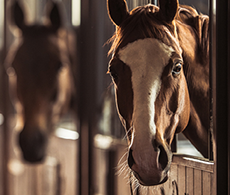
9 checks to complete if you’re stabling a horse this winter
You’re more likely to stable your horse in the winter so, before you do, here’s what you need to check before the wet weather and dark nights arrive.
Unless you reduce summer turnout due to concerns about equine obesity or laminitis, the chances are that your horse is likely to spend more time in a stable over the winter months.
Whether you bring your horse in out of choice or necessity, stabling them will limit damage to your fields and help protect your horse from wet weather and winter skin conditions. This could in turn prevent you from needing to make a claim on your horse insurance. Elements of stabling are hard work, but there are certainly positives.
Before you stable your horse this winter, it’s wise to give your stable setup a bit of an MOT to ensure it’s ready to stand up against the wind, rain, frost and snow. Some of the checks you’ll be able to do for yourself and rectify accordingly, while some are likely to be the responsibility of your yard owner if you’re on livery.
In this case, however, it is sensible to give your stable a once over in case your yard owner has missed something – you’re the one who uses your stable each day, so you’ll know it well. Here’s where to start.
Download your winter stable maintenance checklist here.
1. Ventilation
While you don’t want your stable to be draughty, it’s important that it is well-ventilated so your horse has fresh air. Adequate ventilation is important for removing dust spores and stagnant air, while also preventing moisture build up and, therefore, mould.
2. Lighting
Check that the lighting is working, replace any dead bulbs and clear cobwebs from your fixings. If you don’t have adequate mains-powered lighting in and around your stable, consider investing in a rechargeable light source – the types designed for construction workers are usually a good option, as you can hang them easily.
3. Insulation
Fixing any holes and cracks will help keep your horse that bit more comfortable. Repairing any damage to the roof, fixing any leaks and ensuring good drainage before the wet weather arrives will also really pay off.
4. Pipes and taps
Arriving at the yard in darkness only to find the taps are frozen is one of the most frustrating things for a horse owner in winter. While there may not be a lot you can do yourself to prevent pipes freezing underground, you can insulate accessible piping and taps. Keep water containers filled and to hand as a precaution, as well as a full kettle, ready to boil, to help defrost the frozen taps.
5. Gritting salt
Having an easy-to-access store of gritting salt will help prevent outside areas from icing over, which will improve yard safety, as this is a hazard to both human and horse.
Before rain falls and ice forms, lay salt in high-traffic areas and outside stables to have the best chance of preventing accidents. Be careful, however, if you take your dog to the yard – grit and salt on a dog’s paws can be dangerous and even fatal if ingested.
6. Stable enrichment
Stock up on stable enrichment options to keep your horse entertained while they are stabled.
Consider salt licks, ball feeders, mirrors, hanging toys and scratching pads to provide a variety of stimulation. Some of these can be homemade, too, which will save money.
7. Rugs
Having a good sort through your rug wardrobe before the winter is a really useful job, especially if you’ve not given it a second thought since you put the rugs away in spring.
Check over each rug and sort for cleaning and repairs. It’s also a good idea to set up an area where you can dry rugs over the winter. If your horse is still dry underneath a wet rug, leaving the rug on them to dry out is often the easiest way to do this.
8. Tack
Make sure your tack is stored as well as it can be. If you’re not riding regularly for any reason, check it for mould and wipe it down each week.
Avoid leaving tack anywhere cold and damp, clean it regularly and invest in a saddle cover and/or bridle bag to offer additional protection.
9. Hay and bedding
Ordering hay and bedding in advance (if this is not covered by your livery plan) will ensure your supply for the winter.
Even if you only have the space and funds to store a small amount in advance, being prepared in the event you have to stable your horse earlier than expected will significantly reduce stress.
Do you have any winter preparation tips that have saved you time, money and hassle? Share them with us over on Petplan Equine’s Facebook page.



